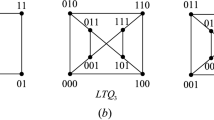Abstract
This paper presents a new interconnection network topology, called the twisted-cube connected network, which is a generation of the twisted 3-cube. The twisted-cube connected network is a variant of the hypercube, and it has a better recursive structure. The regularity, connectivities, subgraphs of the twisted-cube connected network are studied. The twisted-cube connected network is proved to be a 3-cube-free network, which is the essential differnce from the hypercube and variants of the hypercube. An efficient routing algorithm is proposed, and the diameter ofn-dimensional twisted-cube connected network is proved to be just\(\left[ {\frac{{n + 1}}{2}} \right]\) which is less than that of the hypercube.
Similar content being viewed by others
References
Saad Y, Schultz M H. Topological properties of hypercube.IEEE Trans. Comput., 1988, 37(7): 867–872.
Esfahanian A H. Generalized measures of fault tolerance with application ton-cube networks.IEEE Trans. Computers, 1989, 38(11): 1586–1590.
Esfahanian A H, Ni L M, Sagan B E. The twistedN-cube with application to multiprocessing.IEEE Trans. Computers, 1991, 40(1): 88–93.
Cull P, Larson S M. The Möbius cubes.IEEE Trans. Computers, 1995, 44(5): 647–659.
Efe K. A variation on the hypercube with lower diameter.IEEE Trans. Computers, 1991, 40(11): 1312–1316.
Efe K. The crossed cube architecture for parallel computation.IEEE Trans. Parallel and Distributed Systems, 1992, 3(5): 513–524.
Kulasinghe P, Bettayeb S. Embedding binary trees into crossed cubes.IEEE Trans. Computers, 1995, 44(7): 923–929.
Bondy J A, Murty U S R. Graph Theory with Applications. The Macmillan Press Ltd., 1976.
Katseff H P. Incomplete hypercubes.IEEE Trans. Computers, 1988, 37(5): 647–659.
Author information
Authors and Affiliations
Corresponding author
Additional information
Supported by NNSFC and scientific research project of Liaoning Educational Commission.
WANG Deqiang received his B.S. degree from Liaoning University in 1982, and his M.S. degree from Dalian Maritime University in 1990. He has been an Associate Professor at Dalian Maritime University since 1994. He is now a Ph.D. candidate of computer science at Northeastern University. His research interests include fault-tolerant computing, network reliability and computer architecture.
ZHAO Lianchang received the diploma in mathematics in 1963 from Northeast Institute of Technology, China. He was a visiting scholar at Department of Mathematics, University of Pittsburgh (USA) from 1980 to 1982. He was a Professor of mathematics from 1989 to 1994 at Northeastern University. He has been a Professor of mathematics at Dalian Maritime University since 1995. His main research interests are graph theory, design and analysis of algorithms and network reliability.
Rights and permissions
About this article
Cite this article
Wang, D., Zhao, L. The twisted-cube connected networks. J. Comput. Sci. & Technol. 14, 181–187 (1999). https://doi.org/10.1007/BF02946526
Received:
Revised:
Issue Date:
DOI: https://doi.org/10.1007/BF02946526




